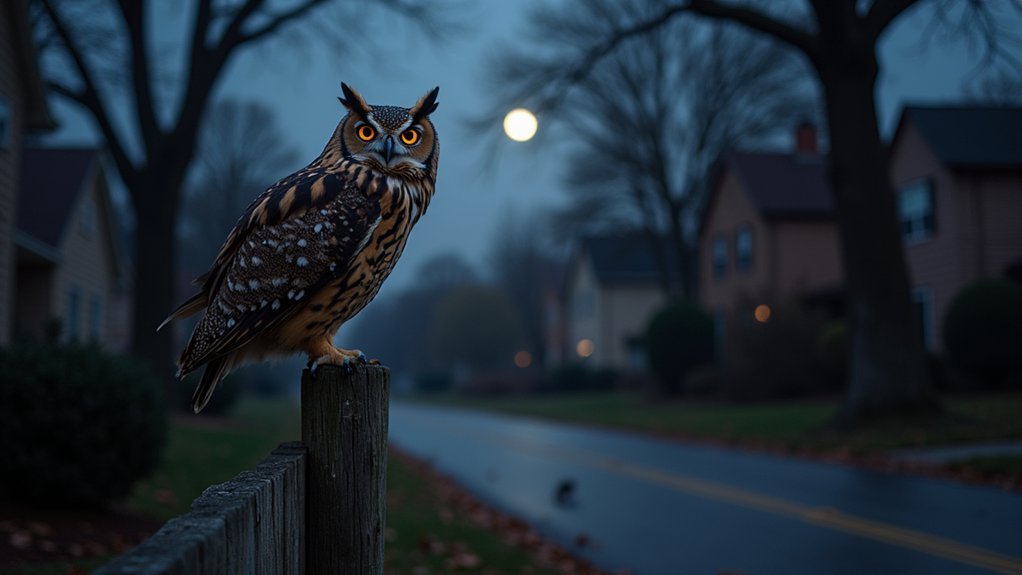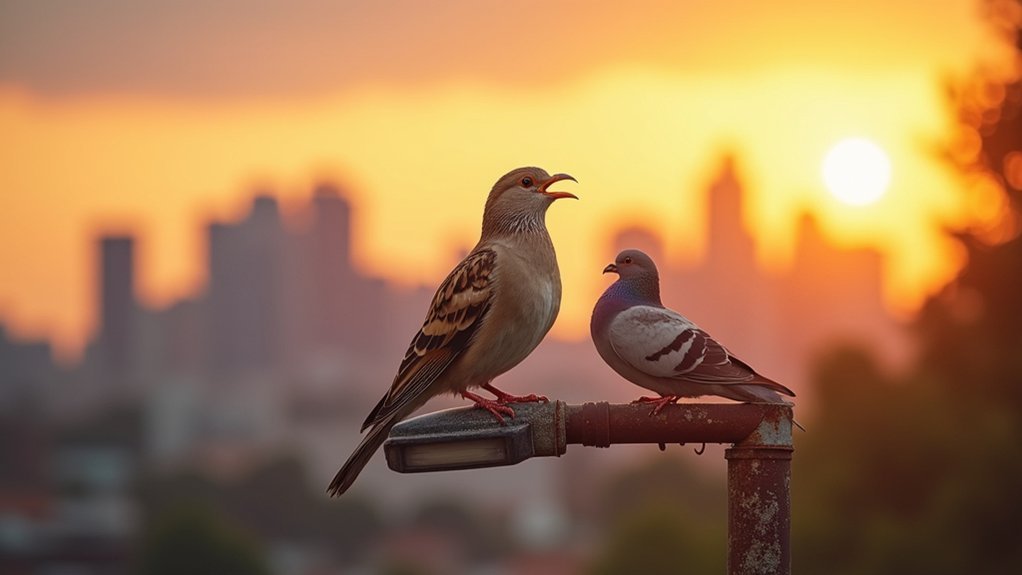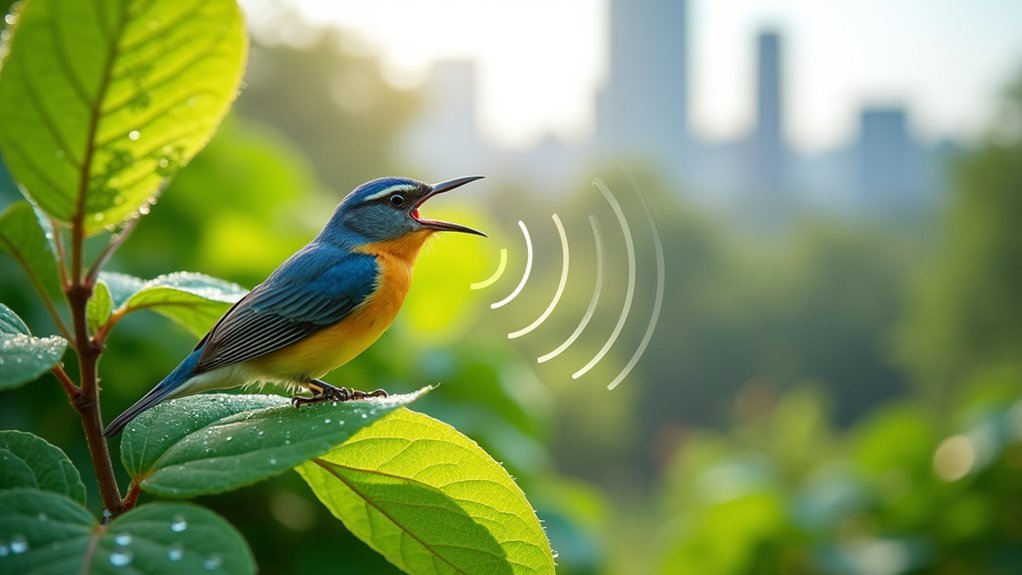Urban owls expand their territories fourfold at night, with GPS tracking revealing they prefer wealthy neighborhoods with more green spaces. You’ll find them hunting rats, insects, and small birds, particularly in areas with high rodent populations. Their success varies dramatically between neighborhoods, with light pollution disrupting natural hunting patterns. Researchers create mouse density maps to identify hunting hotspots, showing that about 33% of urban spaces provide ideal hunting grounds for these adaptable predators.
Numeric List of Second-Level Headings

While tracking owl hunting habits, researchers have identified several key patterns that shape their urban behavior.
You’ll find these fascinating insights organized into clear sections:
- Nocturnal Range Expansion: How owls’ territories grow four times larger at night
- Urban Habitat Preferences: The 33% of Baton Rouge that provides ideal hunting grounds
- Socioeconomic Habitat Correlation: Why wealthier neighborhoods support more owls
- Diet Adaptation in Urban Environments: What city-dwelling owls are eating
- Technology in Owl Research: How GPS-accelerometer tags reveal distinct behavioral patterns
These headings structure our understanding of how owls navigate and utilize urban environments.
The research highlights the critical relationship between city planning, green spaces, and wildlife conservation.
You’ll gain insight into how these magnificent predators have adapted their hunting strategies to thrive alongside human development.
The Nocturnal Hunters Among Us: Urban Owl Species
You’re likely sharing your urban space with several owl species that have mastered city living, including Eastern Screech-Owls, Barred Owls, and Great Horned Owls.
These remarkable nocturnal hunters adapt their behavior to thrive in human-dominated landscapes, expanding their hunting ranges at night to find rats, insects, and small birds.
While some urban areas provide better habitats than others, you’ll find these owls utilizing tree cavities for nesting and open spaces like parks and golf courses for hunting their prey.
Common City Owl Species
Three remarkable owl species have successfully adapted to urban environments, becoming silent neighbors most city dwellers rarely notice.
The Eastern Screech Owl, measuring just 6-10 inches, defends territory with distinctive whinny calls that echo through suburban areas.
You’ll recognize Barred Owls by their cream and brown coloration and their memorable “who-cooks-for-you” hooting pattern. These adaptable hunters thrive in urban woodlands where rodents abound.
The Great Horned Owl, identifiable by its feathery ear tufts, broadcasts gravelly hoots at dusk while patrolling various city habitats.
All three owl species capitalize on abundant urban food sources, with research showing that 33% of Baton Rouge provides preferred nocturnal hunting grounds.
The presence of these predators underscores the essential importance of preserving green spaces within our cities.
Adapting to Urban Environments
Although often unnoticed, urban owls have developed remarkable adaptations that allow them to flourish among skyscrapers and suburbs alike. Barred Owls cleverly repurpose utility poles and large trees for nesting, while Eastern Screech-Owls tuck themselves into tree cavities near human homes.
You’ll find these resourceful hunters expanding their territories considerably at night. Tagged Barred Owls in Baton Rouge demonstrate this behavior with a fourfold increase in their home range after dark, searching for prey across the urban landscape.
Unfortunately, habitat availability isn’t equitably distributed. Research reveals that wealthier neighborhoods often provide better environments for these nocturnal residents.
This disparity highlights the importance of inclusive green space planning to guarantee urban owls can thrive throughout our cities, regardless of neighborhood demographics.
Signs of Successful Hunts: Decoding Feathers and Pellets

You’ll discover that owl pellets contain valuable evidence of their diet, with bones, fur, and feathers telling the story of recent hunts.
When examining these remains, look for feather patterns and sizes to identify the prey species and assess the owl’s hunting prowess.
Collecting and analyzing pellets from beneath roosting sites can reveal preferred hunting grounds and the remarkable success rate of these silent predators in your neighborhood.
Identifying Prey Remains
Successful owl hunts leave behind distinctive evidence that wildlife researchers can decode with remarkable precision. When you’re searching for signs of owl activity, look for regurgitated owl pellets containing bones, fur, and feathers—telltale remains of prey in the dark.
| Prey Evidence | What It Reveals |
|---|---|
| Bone fragments | Species identification |
| Small mammal fur | Rodent consumption |
| Bird feathers | Avian predation |
| Skull remains | Prey size estimation |
| Whitewash deposits | Active hunting locations |
You’ll find these clues beneath roosting spots where owls process their meals. By examining pellet contents, you can determine exactly what the owl has been hunting. Different feather types point to specific bird species, while bone structures identify rodents. Whitewash on tree trunks or ground serves as another indicator that you’ve found an owl’s preferred hunting territory.
Pellet Analysis Essentials
Examining owl pellets offers a direct window into nocturnal predation patterns that might otherwise remain hidden from researchers.
When you collect these regurgitated masses from beneath roosting sites like trees or utility poles, you’re gathering valuable data on prey selection and hunting success.
You’ll find that owl pellets contain indigestible parts—bones, fur, and feathers—that reveal which prey species the owl has captured.
The specific feather patterns and bone sizes correlate to particular prey types, allowing you to identify exactly what the owl has been hunting.
Prime Hunting Grounds: Where City Owls Prefer to Feed
Urban owls have developed sophisticated hunting preferences within city boundaries, making certain areas hotspots for their nocturnal feeding activities.
You’ll find these raptors gravitating toward neighborhoods with abundant green spaces, parks, and gardens that attract their preferred prey.
Research in Baton Rouge revealed that 33% of the city provides ideal nocturnal hunting habitat for urban owls.
Wealthier neighborhoods often offer superior hunting grounds due to their extensive landscaping and diverse vegetation that supports rodent and small bird populations.
At night, owls expand their territories up to four times their daytime range, adapting remarkably to city environments.
When tracking owl activity, look for telltale signs like pellets and whitewash beneath trees—these markers indicate active feeding sites nearby.
Seasonal Shifts in Prey Selection and Hunting Territories

As seasons change, so do the hunting patterns of city-dwelling owls, who demonstrate remarkable flexibility in both prey selection and territorial coverage. You’ll notice Barred Owls expanding their hunting territories fourfold at night, adapting to urban landscapes with strategic precision.
| Season | Prey Selection | Hunting Territory |
|---|---|---|
| Winter | Rats, house sparrows | Expanded (4x daytime range) |
| Spring | Varied natural prey | Balanced urban-natural areas |
| Fall | Shifting diet | Affluent areas (33% suitable) |
Winter brings abundance in unexpected places—affluent neighborhoods offer 33% suitable hunting habitat compared to just 5% for daytime activities. During colder months, you’ll find these adaptable predators focusing their efforts where rats and house sparrows proliferate, altering their hunting territories to maximize success when natural areas become less productive.
Technological Tools for Tracking Nighttime Predation
Modern technological advances have revolutionized our ability to study owl hunting behaviors with unprecedented precision. GPS-accelerometer tracking devices now capture detailed data on Barred Owls’ nocturnal activities, revealing how their territories expand considerably at night during hunting.
You’ll find these tools particularly valuable for urban wildlife conservation efforts, as they:
- Measure precise movement patterns and energy expenditure during nighttime foraging
- Identify specific urban areas where owls are most active, highlighting critical habitats
- Provide data showing that substantial portions of cities (33% in Baton Rouge) offer suitable hunting grounds
Urban Rodent Populations: The Owl’s Buffet

Urban areas experience significant rat population booms that provide owls with an abundant food source throughout the year.
You’ll find mouse density highest around green spaces and residential areas with improper waste management, creating prime hunting grounds for nocturnal predators.
These residential rodent hotspots become reliable feeding stations for urban owls, who’ve adapted their hunting strategies to capitalize on humanity’s unintentional pest cultivation.
Rat Population Booms
Cities across the world have transformed into unintentional rat havens, creating what ecologists now recognize as perfect hunting grounds for adaptable owl species. The urban rat population has exploded due to three key factors:
- Abundant food waste in densely populated areas
- Numerous shelter opportunities in building infrastructures
- Fewer natural predators in city environments
You’ll find Great Horned Owls particularly thriving in this new ecosystem. These powerful hunters have adapted remarkably well to urban settings, where they silently patrol neighborhoods during winter when rats become even more concentrated around available food sources.
This natural relationship benefits you too—a single owl family can consume thousands of rodents annually, providing free pest control for your community while maintaining ecological balance in an otherwise disrupted urban environment.
Mouse Density Mapping
While tracking owl hunting patterns across metropolitan areas, researchers have developed sophisticated mouse density maps that reveal the invisible buffet sustaining these aerial predators.
These maps highlight “hotspots” where urban rodent populations thrive, creating perfect hunting grounds for resident owls.
You’ll find that neighborhoods with lush parks and gardens typically show the highest concentration of mice, directly correlating with increased owl activity.
During winter months, these maps become especially valuable as owl hunting habits intensify with the seasonal spike in food-seeking behavior.
Residential Rodent Hotspots
Beyond the manicured lawns and backyard gardens, residential neighborhoods harbor thriving rodent populations that serve as an all-you-can-eat buffet for urban owls.
Your neighborhood’s waste management practices directly influence these hunting grounds, as studies show that poor disposal methods correlate with increased owl sightings.
Various owl species have adapted remarkably to capitalize on urban rodents:
- Great Horned Owls consume significant portions of rats and mice that flourish near your trash bins.
- Eastern Screech-Owls target smaller urban rodents and House Sparrows around residential areas.
- Most owls expand their hunting ranges at night specifically to locate rodent hotspots near homes.
You’ll find these predators most active in densely populated areas where food scraps, gardens, and bird feeders inadvertently create perfect habitats for their prey.
The Impact of Light Pollution on Hunting Efficiency

As darkness falls across natural landscapes, owls typically begin their silent hunt for prey, yet this ancient pattern faces considerable disruption in our modern illuminated world.
These nocturnal birds struggle considerably in urban environments where light pollution transforms their hunting grounds.
You’ll notice owls avoiding brightly lit streets and plazas where they can’t effectively locate prey. Their exceptional night vision, evolved for darkness, becomes a disadvantage under artificial lighting.
When forced to hunt in illuminated areas, they’ll expend more energy with fewer successful captures.
The city’s glow also shifts their natural hunting schedule, pushing these predators to forage during suboptimal times.
This disruption creates a cascading effect—altering their circadian rhythms and forcing them to compete for limited resources in the few remaining dark pockets of urban landscapes.
Neighborhood Differences in Owl Hunting Success Rates
Despite sharing the same urban environment, owls experience dramatically different hunting outcomes depending on which neighborhood they frequent.
You’ll notice these remarkable hunters adapt their techniques based on local conditions, especially around tree trunks where prey species often hide.
Research reveals three key neighborhood factors affecting owl hunting success:
- Green canopy coverage – Areas with more trees provide 4x larger nighttime hunting territories and support greater prey diversity.
- Socioeconomic status – Wealthier neighborhoods typically offer more diverse nocturnal habitats, enhancing hunting opportunities.
- Prey availability – Neighborhoods with abundant small mammals and House Sparrows yield considerably higher success rates.
Your neighborhood’s specific environmental characteristics directly influence whether local owls thrive or struggle, with some urban zones providing surprisingly productive hunting grounds for these adaptable predators.
Citizen Science Opportunities: Documenting Urban Owl Diets
These neighborhood differences in hunting success present an exciting opportunity for you to contribute meaningful data about urban owls.
You can start by collecting owl pellets found beneath roosting sites, which contain valuable evidence of their dietary preferences. When you examine these pellets, you’ll discover undigested remains of small mammals, birds, and insects.
Join local owl monitoring programs to report your sightings and observations of hunting behaviors. Parks and green spaces, with their higher biodiversity, make ideal locations for your citizen science efforts.
Conservation Implications of Owl Predation Patterns
When researchers analyze urban owl hunting patterns, they uncover critical connections between predator behavior and city planning decisions.
You’ll find that owl predation patterns directly reflect the health of our urban ecosystems, with studies showing that owls expand their hunting territories fourfold at night in cities.
Effective urban habitat planning must consider:
Urban planners must integrate nocturnal habitat needs and prey diversity when designing green spaces that support owl populations.
- The stark contrast between available nocturnal habitat (33% in Baton Rouge) versus diurnal habitat (only 5%)
- The need for equitable distribution of green spaces that support diverse prey populations
- Conservation strategies that maintain small mammal populations threatened by urbanization
Frequently Asked Questions
How to Find an Owl in Your Neighborhood?
You’ll find owls by looking for whitewash and pellets under trees, listening for their calls at dusk, checking wooded areas near clearings, using eBird for recent sightings, and observing quietly with patience.
What Time of Day Do Most Owls Hunt?
Most owls hunt during twilight and nighttime hours. You’ll find them most active shortly after sunset and before dawn when their prey is moving about. They’re perfectly adapted for nocturnal hunting with exceptional vision.
Is It Normal to See Owls in the City?
Yes, it’s entirely normal to see owls in cities. You’ll find species like Barred and Eastern Screech-Owls thriving in urban areas with large trees. They’re especially visible during winter when trees are leafless.
Do Owls Stay in Neighborhoods?
Yes, owls do stay in neighborhoods. You’ll find them establishing territories where they have access to food and nesting sites. They’re adaptable and can thrive in urban areas with sufficient green spaces and trees.
In Summary
You’ve seen how urban owls adapt their hunting to city life, working around our lights and finding prey in unexpected places. By tracking these patterns, you’re helping scientists understand these predators’ resilience and needs. When you document owl activity in your neighborhood, you’re contributing to conservation efforts that guarantee these nocturnal hunters remain part of our urban ecosystem for generations to come.





Leave a Reply